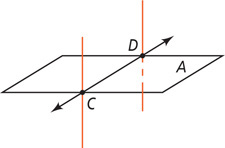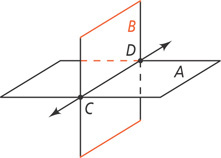Concept Byte: Perpendicular Lines and Planes
Use With Lesson 3-4
ACTIVITY
As you saw in Chapter 1, you can use a polygon to represent a plane in space. You can sketch overlapping polygons to suggest how two perpendicular planes intersect in a line.
Activity
Draw perpendicular planes A and B intersecting in
Step 1 Draw plane A and
Step 2 Draw two segments that are perpendicular to
Step 3 Connect the segment endpoints to draw plane B. Plane B is perpendicular to plane A because plane B contains lines perpendicular to plane A.



Exercises
- Draw a plane in space. Then draw two lines that are in the plane and intersect at point A. Draw a third line that is perpendicular to each of the two lines at point A. What is the relationship between the third line and the plane?
-
- Draw a plane and a point in the plane. Draw a line perpendicular to the plane at that point. Can you draw more than one perpendicular line?
- Draw a line and a point on the line. Draw a plane that is perpendicular to the line at that point. Can you draw more than one perpendicular plane?
- Draw two planes perpendicular to the same line. What is the relationship between the planes?
- Draw line l through plane P at point A, so that line l is perpendicular to plane P.
- Draw line m perpendicular to line l at point A. How do m and plane P relate? Does this relationship hold true for every line perpendicular to line l at point A?
- Draw a plane Q that contains line l. How do planes P and Q relate? Does this relationship hold true for every plane Q that contains line l?
Table of Contents
- 6-1 The Polygon Angle-Sum Theorems
- 6-2 Properties of Parallelograms
- 6-3 Proving That a Quadrilateral Is a Parallelogram
- 6-4 Properties of Rhombuses, Rectangles, and Squares
- 6-5 Conditions for Rhombuses, Rectangles, and Squares
- 6-6 Trapezoids and Kites
- 6-7 Polygons in the Coordinate Plane
- 6-8 and 6-9 Coordinate Geometry and Coordinate Proofs




